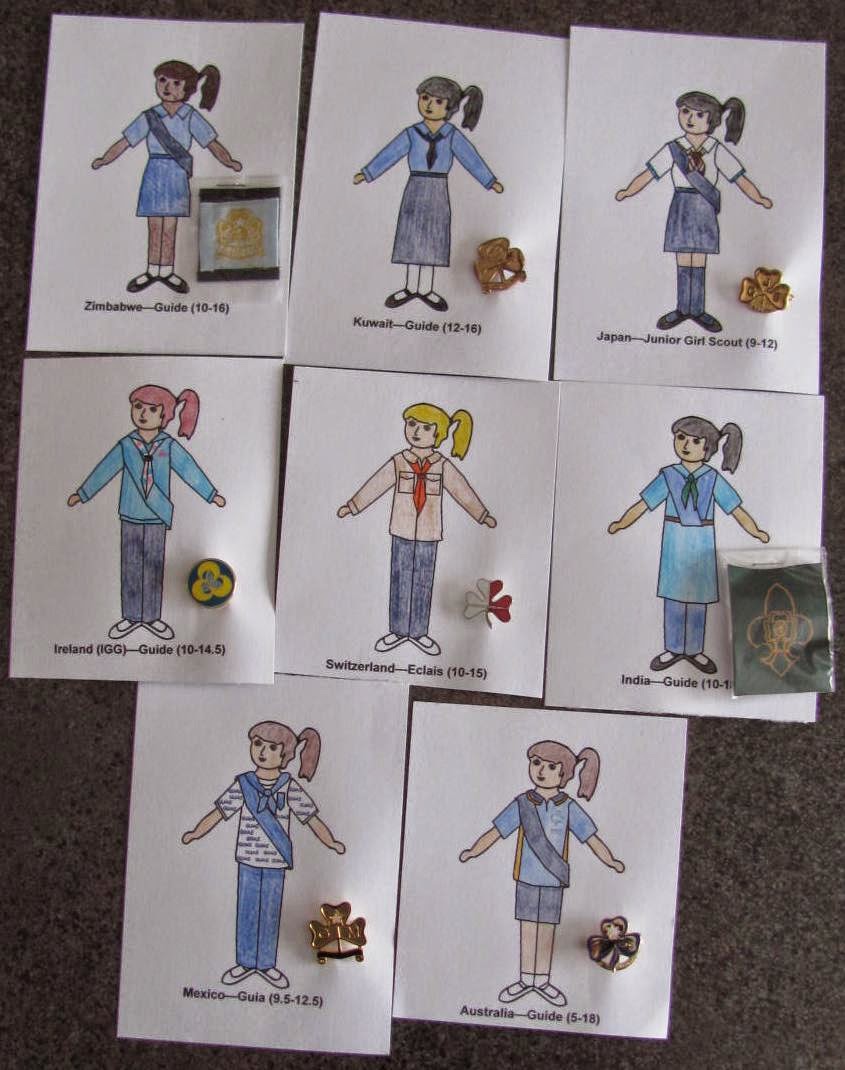 On Tuesday, February 24th all of the units in Caledonia got together to celebrate World Thinking Day. As the girls arrived, they made World Thinking Day bookmarks to trade with
On Tuesday, February 24th all of the units in Caledonia got together to celebrate World Thinking Day. As the girls arrived, they made World Thinking Day bookmarks to trade with each other later in the evening.
 We began our evening with the Spark, Brownie and Guide openings and a brief welcome and introduction to the theme for World Thinking Day - "We Can Create Peace Through Partnerships" and our service project for the evening. As a service project, we made bookmarks for the Student's Rebuild Literacy Challenge. By making 95 bookmarks, the Bezos Family Foundation will donate $95 to Save the Children's Literacy Boost Programs in Peru, Mali and Nepal. We will also be forwarding $55 to the Canadian World Friendship Fund.
We began our evening with the Spark, Brownie and Guide openings and a brief welcome and introduction to the theme for World Thinking Day - "We Can Create Peace Through Partnerships" and our service project for the evening. As a service project, we made bookmarks for the Student's Rebuild Literacy Challenge. By making 95 bookmarks, the Bezos Family Foundation will donate $95 to Save the Children's Literacy Boost Programs in Peru, Mali and Nepal. We will also be forwarding $55 to the Canadian World Friendship Fund.The girls were divided into 5 colour groups and the Guiders led their groups through the 5 planned activities. Through our activities, we explored World Guiding, the World Centres, and the Millennium Development Goals (MDGs). There was approximately 10 minutes for each activity, with a few minutes at the end to finish up crafts.
Activity A - World Centres - Sangam
Craft - Rangoli Art
At this station, the girls located the World Centres on a large world map, then created their own Rangoli designs using chalk on black card stock.
Activity B - MDG 2 - Education
Service Project - Celtic Knot Bookmarks
At this station, we worked on our service project for the evening. The girls were reminded that not all children are able to go to school and that by making bookmarks we were helping to children in other countries learn to read and write. The bookmarks we made had a celtic knot design, which the girls coloured and then glued onto a piece of card stock and added a piece of ribbon as a tassel.
Activity C - MDG 1 & 7 - Poverty & Environment
Activity - Plastic Bag Ball & African Handball
At this station, it was explained that not all children have money to buy toys and electronics, and they often make their own games from scrap materials. One object that is commonly made is a ball. The girls were shown how to make a ball using a wad of newspaper and plastic bags, then used a pre-made ball to play African Handball. In this game, the players are divided into two teams. Each team tries to keep control of the ball for as long as possible by tossing it back and forth between players - at the same time, the other team tries to intercept the ball. The player holding the ball cannot 'travel' with it and must throw it to another player before moving. When a player catches the ball, the other players on her team clap their hands and stamp their feet.
Activity D - MDG 8 - Partnerships
Activities - There's No I in Team
At this station, the girls practiced working together through three team building activities. The first activity was Pass the Can - in this activity, players sit in a circle and pass a coffee can around the circle using only their feet. If the can falls off someone's foot, the group starts over. The second activity was Sardines - in this activity, all the girls in the group stand on a tarp, making sure no one's feet are touching the floor. Everyone then gets off, and the tarp is folded in half. Continue folding the tarp in half and see how small it can be before the group can no longer fit onto it. The third a activity was Tarp Turn-Over - in this activity, a group stands on a tarp and tries to turn it over without anyone stepping off.
Activity E - WAGGGS - Twinning 2020: Ontario & Chile
Game - Corre, Corre la Guaraca
At this station, the girls located Chile on a world map and learned that Ontario will be twinning partners for 2015-2016. The girls then played the game "Corre, Corre la Guaraca". In this game, the group sits in a circle while one player jogs around the outside with a handkerchief. Trying not to be felt, the runner drops the handkerchief on a players back and runs. If she makes it around the circle before the seated player realizes the handkerchief is on her back, the runner picks up the handkerchief and goes around the circle again. If the seated player catches on, she must get up and try to tag the runner. If she succeeds, the runner sits down and the second player becomes the runner. If she fails to catch her, they play again.
After the stations were completed, the girls had a few minutes to finish up their bookmarks for trading, the bookmarks for the service project and/or their rangoli art. They then had the opportunity to trade bookmarks with another girl.
We ended the evening with a snack (cupcakes and juice boxes) and singing "Fire's Burning" in a round, followed by Spark, Brownie and Guide closings.















